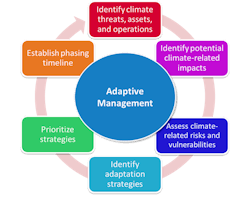Using Adaptive Management to Integrate Climate Change Considerations
There are many factors affecting how future climate change impacts are being considered by airports around the world. Most notably, airports that have been affected by severe storms or experiencing sea level rise effects, storm surge and high tides today are seeking answers and planning adaptation measures. Further, various government agencies are developing criteria and requirements for considering climate change effects on public infrastructure with lifespans well beyond 50 years.
But the effects of climate change won’t only impact coastal airports. Across the United States, weather delays accounted for 38.4% of total aircraft delay minutes in 2018, according to the Bureau of Transportation Statistics.
As the climate continues to change, that number has the potential to increase. With the potential for increased delays due to weather, all airports need to consider the possible effects of climate change.
Many Ways to Prepare
Assumed weather and climate conditions are typically incorporated into existing airport management systems; however, the expectations for weather and climate are usually based on historical conditions. As the effects of climate change become more prevalent, airports should investigate opportunities to incorporate climate change into existing planning, design and operations – and small changes can have large benefits.
These changes could be made to master plans and capital improvement programs for infrastructure improvements with lifespans well beyond 50 years, or continuity of operations plans and emergency response plans providing a means to evaluate risks and prepare for vulnerabilities.
But there are many gaps that may prevent airports from adequately responding today. While the Airport Cooperate Research Program (ACRP) provides excellent tools and resources, future design standards, legal and insurance protections, and funding mechanisms have not yet been determined. In the U.S., with the roll-back of a national legislative framework, individual states and regions are left to address these gaps on their own.
The question remains — when should airports incorporate mitigation? Identifying vulnerabilities is the first step.
Armed with an understanding of potential vulnerabilities, airports can take an adaptive management approach to addressing the vulnerabilities. Adaptive management is a systematic approach to managing uncertainty that promotes flexible decision-making as information evolves and becomes available.
Climate-related impacts to airport infrastructure and operations are not generally tracked, synthesized or evaluated. Understanding effects as they occur and reviewing trends at regular intervals will help to determine if a trigger point or threshold for action is approaching.
Considering cost-benefit analysis is another important element in determining when to invest in adaptation measures. Airports can do this by calculating the cost of a climate-induced impact – including infrastructure damage, loss of use, and recovery costs – and comparing the sum to the cost of mitigation will provide the data needed to make informed adaptive management decisions.
Because of the changing nature of both climate change and airports, an adaptive management approach to addressing vulnerabilities will need to be revisited on a regular basis to ensure that the methods selected for the mitigation of climate change are adequate for the current conditions.
Challenges and Opportunities on the Horizon
In 2018, the Intergovernmental Panel on Climate Change (IPCC) released a report that indicated drastic greenhouse gas emission reductions are needed quickly to maintain only 1.5 degrees Celsius of global warming. The report further recognizes that greenhouse gas mitigation will not reverse the trend in the short-term, and therefore adaptations are even more important.
A practical challenge for airports remains uncertainty in weather and climate predictions and how future technology, rather than mitigation, will provide a means to address the effects. Sea level rise and rising temperatures are very likely and highly certain to occur. Increases in the intensity and severity of storms is anticipated; however, just how severe is difficult to predict today at the local level. Although changes in the climate are certain, the scale and level of change is less certain.
However, uncertainty in any aspect of climate change is no excuse to not take action. Adaptive management as described above can help.
In early 2018, the National Institute of Building Sciences (NIBS) found that every dollar invested in disaster mitigation by three federal agencies saves society $6. The October 2018 United Nations Office for Disaster Recovery Report demonstrates that economic losses over the last 20 years have tripled compared to the prior 20 years, with the U.S. having the greatest economic losses in the world.
California, which has the fifth largest economy in the world, is leading efforts to help address the gaps that prevent climate adaptation and resiliency efforts. Both the insurance and financial sectors are establishing expectations, which will likely drive how we view climate change risk and opportunities. These activities will certainly trickle down to airports in the coming years.
California passed groundbreaking legislation in 2016 that provides an opportunity to review the climate change adaptation issue in a comprehensive manner. In September 2018, the working group released the report Paying It Forward, the Path Toward Climate-Safe Infrastructure in California.
The California report is a comprehensive review of expected effects and the associated vulnerabilities. It identifies data gaps and suggests governance structure, policy and funding needs as well as an implementation strategy that will help policymakers establish a program to combat climate change effects in California.
Risk Management Responses
Also in September 2018, insurer Zurich issued the report Managing the Impacts of Climate Change: Risk Management Responses. Zurich suggests that every industry sector and government must consider physical impacts of climate change.
It may only be a short time until the insurance industry reflects those risks in insurance premiums using data they evaluate independently. Being prepared with your own vulnerability information will likely ensure that your airport is being properly characterized.
The Financial Stability Board (FSB) is an international body that monitors and makes recommendations about the global financial system. In 2016, the board formed the Task Force on Climate-related Financial Disclosures (TCFD).
Over the last several years, the Task Force has been gaining momentum with more than 800 public and private sector supporters, including the financial, industrial, information technology, materials, telecom and utility sectors in North America, participating in the development of financial disclosure guidelines related to climate change induced risks. Last fall, the Task Force issued its first status report summarizing the results of financial disclosure report audits and recommending a disclosure path forward.
Funding and Financial Implications
While most airports in the U.S. are public or quasi-public entities, most cannot rely solely on AIP funding; typically, bonds are issued to pay for improvements. As the Task Force’s disclosure recommendations become more pervasive in the financial and insurance sectors, airports may start to see expectations that climate-related risks and vulnerabilities are understood and provided as a part of the financial disclosure packages issued for their bonds.
JetBlue is currently the sole aviation-specific supporter, but many U.S.-based financial institutions are also supporting the recommendations of the Task Force. The private sector is recognizing the need for governance, thoughtful resiliency strategy development, risk management and target development and is taking a leadership role.
Airports will be impacted by these financial and insurance approaches in the near future. Preparation will be key to long-term success.
Looking Forward
A changing climate will impact the aviation industry. Although the timing and scale of the changes to the climate may be uncertain, airports have the opportunity now to begin to assess vulnerability to climate change to prepare for the future. Taking an adaptive management approach allows airports to accommodate the uncertainty associated with climate change and integrate these decisions into their existing systems.
RS&H Vice President John Lengel, PE, ENV SP, serves on both the Environmental Steering Group and the Water Quality Subcommittee in the ACI-NA, as well as the ACI World Environment Standing Committee. He is heavily involved with the AAAE, having been on the Environmental Committee, and for the last 5 years served as Environmental Committee Water Quality Chair. He can be reached at [email protected].
Environmental Specialist Rikki Vela ENV SP, serves as a Planner for RS&H’s Aviation Practice in the firm’s San Antonio, Texas office. She has experience with airfield facility planning, sustainability metrics and assessments, ALP updates, Pavement Condition Inspections using new tablet recording technology, and GIS. She can be reached at [email protected]





